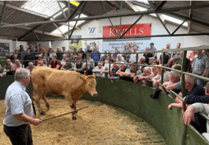Photographer Ray Roberts takes us around the local lanes for nest spotting and points out a poisonous plant....I have to admit that I am far too old now to bother about trying to spot birds’ nests in the hedges and bushes, but quite by chance I was walking along one of our narrow roads near the village, when a blackbird flew out into the road from the hedge. Naturally I went over for a closer look and there, hardly hidden away but in full view, was a nest with five eggs in it. I think this must be the second clutch of eggs that the blackbird had laid as it was now May month and these birds start laying two or three clutches of four to five eggs beginning in March.
The hedges around Quethiock are decorated with lots of green alkanet – Pentaglottis sempervirens – with their tall bristly stems and long oval leaves. Its multiple blue flowers are similar, in colour and size, to those of forget-me- not plants and the plants were once cultivated for the red dye that can be extracted from their roots. Brought over from Spain in the Middle Ages as a garden flower where it was much prized but tends to be invasive if not managed properly.
There is also lots of dog’s mercury – Mercurialis perennis – on the hedges and in the woods where it spreads on creeping rhizomes and can cover a large part of the woodland floor. The plant produces dainty flower spikes of greenish flowers and is very poisonous.
On the subject of floral displays, the common dandelion - Taraxacum officinale – provides beautiful decorations with its yellow blooms which turn into ‘clocks’ of seeds. However, although you have got to admit the flowers look lovely on the hedgerow the plant is very much hated by gardeners as they pop up without warning, especially on lawns.
I have noticed several speckled wood butterflies during the past week. A small butterfly that favours shaded hedgerows and woodland glades, where they fly to and fro, occasionally pitching for a short rest. They can be seen in flight from April to September in two successive broods.
I can’t resist walking near any water, be it a river, stream or pond and one of my trips took me near to a small pond where there were a couple of Canada geese meandering around enjoying the sunshine. These geese were introduced to Britain from America during the seventeenth century to populate the formal lakes and parks, but are now widespread across England. Groups of them fly in a distinctive V pattern, never seeming to be in any hurry and calling with their familiar ‘honking’ sound as they pass overhead.




.jpg?width=209&height=140&crop=209:145,smart&quality=75)